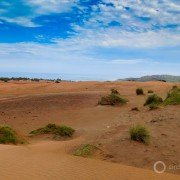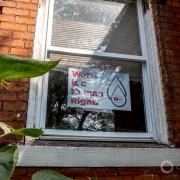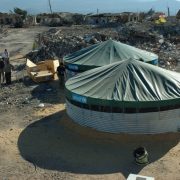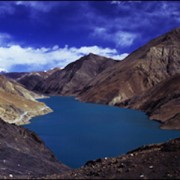2015 Biggest Trends: Water Scarcity Rises to Top Global Concern
After a year of deep droughts, worsening pollution, rising sea levels, and floods, water was finally recognized as perilous to nations and the international economy.
By Keith Schneider
Circle of Blue
JOHANNESBURG — In the last days of 2015, the Famine Early Warning System Network, a forecasting tool, reported that the deepest drought experienced by South Africa in over three decades could lead to grain shortages and spiking food prices. South Africa’s corn harvest, which normally yields a 3 million metric ton surplus that helps feed other African nations, is projected to finish in April with a 500,000 to 600,000 metric ton deficit.
The warning network, an interagency data gathering system established in 1985 by the U.S. Agency for International Development, reported that moisture conditions are even more perilous in mid-continent Africa, where record flooding is occurring in East Africa while the most dangerous drought since the 1960s scorches Ethiopia.
Water: World’s #1 Risk
Here in Africa, just as in much of the world during the last year, water crises gained new urgency. The quantity, quality, and ready access to supplies of fresh water became a top economic and environmental priority. In January, the World Economic Forum declared that flood, drought, and pollution were the top global risks to business and governments. In December, during the successful negotiations in Paris to limit climate-changing carbon emissions, water security was included in the adaptive plans of most nations and was at the core of numerous debates and side agreements.
In the months between the start and the end of 2015 the often disastrous lurch in the Earth’s hydrological cycles prompted substantive changes in policy and practices. California, in its fourth straight year of drought, issued the first restrictions on water use in state history. Driven by public opposition to the harm it could cause to water supplies on the Great Plains and to the climate, President Obama rejected a permit to build the Keystone XL oil pipeline from Canada.
Water and Energy Shift
China, the world’s largest carbon polluter, announced it would reduce water-wasting coal mining and the use of coal in electricity generation. India, too, is shifting to water-conserving wind and solar power. Mexico prohibited new groundwater supply permits for shale oil and gas development in the northern desert state of Coahuila. California shut down injection wells for dumping oilfield waste into groundwater.
How the world regards its freshwater supply is a tale of social, political, and economic transition. Circle of Blue reported in 2015 from the frontlines of a world undergoing rapid ecological change, developing an influential narrative that is helping communities and governments, academia, the media, and public interest organizations to understand the dimensions of an era of great peril – and embryonic promise.
Water: The Central Character
Water is the central character and metaphor in that narrative. Mounting turmoil in the world’s water supply is largely the result of the Earth’s powerful response to industrial degradation of the past 150 years. In 2015, for example, Texas experienced both its worst drought and most dangerous flooding in memory. The biggest lakes in the world are either drying up or harmed by mounting pollution. São Paulo, Brazil’s largest city, is running out of water because of a drought in the normally wet Amazon River basin. Droughts in Zambia and Zimbabwe crippled hydropower production, prompting massive electricity cuts and hindering mining operations.
Rethinking Large-Scale Infrastructure
Recognizing the hazards, communities all over the world are organizing to halt mammoth infrastructure projects in the energy, mining, transportation, and industrial sectors that they assert are out of scale and will make conditions worse. Here in South Africa, for instance, the construction of two of the largest coal-fired power plants in the world has come under withering civic opposition, in part due to the effect the plants would have on local water supplies. Hydraulic fracturing continues to generate scrutiny on water use for energy exploration. A big hydropower dam in India remains unfinished because of public protests. A proposed shipping canal across Nicaragua attracted sharp concern from scientists.
Stranded Assets
The third and newest piece of the narrative is that financial institutions are starting to back away from investments in water-wasting and climate-altering projects. To avoid disastrous warming of the planet, roughly 80 percent of known fossil fuel reserves must not be burned, according to climate activist Bill McKibben. With the global agreement to limit carbon emissions that was signed in Paris, even the mining and extraction of fossil fuels is now a significant business risk. Big banks and investors understand that carbon-heavy fuels will soon become unmarketable – a stranded asset in industry parlance.
New Conclusions
For the time being, the coal sector is most imperiled. Europe’s largest insurer, Allianz, recently joined California’s pension funds and Norway’s sovereign wealth fund, the world’s largest, in selling its coal investments. In August, the Commonwealth Bank of Australia, that nation’s largest bank, said it would not fund the Carmichael mine in Queensland, the biggest coal mine ever proposed in Australia.
Instead, investors are directing more capital to water-conserving and sustainable practices and equipment. In November, for instance, Goldman Sachs, the largest investment bank in the world, announced it was quadrupling its investment in renewable energy to $US 150 billion.
A New Narrative Emerges
Put these chapters together and a new set of conclusions emerge about how people and nations value fresh water. In the United States, the price of municipal drinking water is rising, according to Circle of Blue’s authoritative and widely watched annual survey of 30 cities. We’ve reported on the expanding global awareness of the value of the world’s groundwater, which is being depleted at an unsustainable rate. Circle of Blue also described the value of recycling water and cleansing wastewater of pollutants, both ways to enhance the quality of life in cities around the world.
The concerns expressed about securing water supplies produces mixed responses in governments. At the federal level in the United States, Congress is indifferent to the degradation in national waters that is leading to dangerous outbreaks of poisonous algae. Some governments, though, are driving new policy initiatives that call for sharing scarce resources and much more water conservation. Colorado, for example, approved its first state water plan in December.
Waternews Highlights – 2015
Water Crises Are World’s Top Risk
The California Drought Deepens
Challenged By Drought, Fire, Earthquake, and Flood, California Departs On New Path
Amid California Drought, Oil Industry Wastewater Attracts New Scrutiny
One Way to Ease California Drought: Recycle Wastewater for Irrigation
Infographic: California Urban Water Conservation Standards
The Global Pivot Away From Carbon Fuels Starts In Earnest
China’s Early Pivot Away From Carbon
Slowly, With Earth Pushing Hard, A Confederacy Of Concern Develops
US Water Pollution Meets Indifferent Policy Responses
U.S. Clean Water Enforcement Strategy: Big Penalties But Fewer Prosecutions
America’s Spreading Septic Threat
While South Carolina Floods, U.S. Wrestles with Urban Stormwater
U.S. Clean Water Law Needs New Act for 21st Century
Infographic: U.S. Surface Water Pollution By State
Groundwater Supplies Become A Big Global Worry
Groundwater Depletion Stresses Majority of World’s Largest Aquifers
Here Comes the Sea: The Struggle to Keep the Ocean out of California’s Coastal Aquifers
Australia Coal Mines Prompt Concerns about Groundwater and Climate
Infographic: NASA Satellites Reveal Global Groundwater Depletion
The American West Reshapes Regional Water Strategies
Gila River Diversion Pits New West vs Old
In Drying Colorado River Basin Indian Tribes Are Water Dealers
California Groundwater Law Tests State’s Capacity to Oversee a Vital Resource
Citizens Push Back Against Mega Projects
Panama’s Hydropower Development Defined By Fierce Resistance and Tough Choices
Big India Dam, Unfinished and Silent, Could Be Tomb for Giant Hydropower Projects
Circle of Blue’s senior editor and chief correspondent based in Traverse City, Michigan. He has reported on the contest for energy, food, and water in the era of climate change from six continents. Contact
Keith Schneider











Leave a Reply
Want to join the discussion?Feel free to contribute!